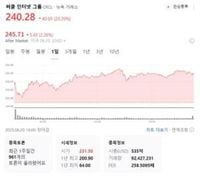Circle Internet Group, the issuer of the stablecoin USDC, has experienced a staggering surge in its stock price since its recent initial public offering (IPO) on the New York Stock Exchange (NYSE) on June 5, 2025. Priced initially at $31 per share, Circle’s stock closed at over $240 on June 20, marking an extraordinary eightfold increase in just over two weeks. This meteoric rise has captured the attention of investors worldwide, especially amid geopolitical tensions and evolving regulatory landscapes.
On June 20, Circle’s stock opened at $231.50, soared to an intraday high of $248.88, and closed at $240.28, representing a 20.39% jump from the previous day. The trading volume was massive, with over 92 million shares exchanged, and the company’s market capitalization reached approximately $53.5 billion, or nearly 74 trillion Korean Won. Such figures underscore the intense investor interest in Circle and its role in the burgeoning fintech and blockchain sectors.
Circle is not just a stablecoin issuer; it is a global fintech powerhouse operating platforms, networks, and market infrastructure tailored for blockchain applications. The company issues USDC, a stablecoin pegged to the US dollar, and EURC, linked to the Euro, alongside a suite of blockchain-specific software infrastructures. Its business extends beyond stablecoins to developer services, integration services, tokenized funds, and liquidity solutions. Circle’s enterprise-grade infrastructure enables developers to connect directly to its services, facilitating the expansion of stablecoin adoption across various blockchain networks.
The rapid ascent of Circle’s stock price has been particularly dramatic in the Korean market as well. Converted into Korean Won, the stock price jumped from 146,000 Won on June 12 to over 150,000 Won by June 20, with several days of double-digit percentage gains in between. For instance, on June 13, the stock surged more than 25%, followed by a 13% rise on June 16, a slight dip on June 17, and then a near 34% jump on June 18. After the Juneteenth holiday, the price rallied again by over 20% on June 20. In just five trading days, the stock more than doubled, reflecting extraordinary momentum.
This surge occurred against the backdrop of geopolitical uncertainty, notably the heightened tensions between Israel and Iran, and the U.S. military’s recent strike on Iran’s nuclear facilities. Interestingly, despite these global risks, cryptocurrencies such as Bitcoin and Ethereum saw modest price increases immediately following the U.S. action. Circle’s USDC, primarily used as a transaction medium rather than an investment vehicle, stands to benefit indirectly from such market dynamics. Stablecoins often serve as inflation hedges during periods of rising prices, and an escalation in Middle East conflict could trigger short-term spikes in oil prices, potentially boosting Circle’s stock further.
However, the driving force behind Circle’s recent stock rally is not solely geopolitical. On June 17, the U.S. Senate passed the so-called “Gensler bill,” a piece of legislation aimed at regulating the issuance and operation of stablecoins. While the bill is framed as a regulatory measure, many analysts view it as a crucial step toward integrating stablecoins into the traditional financial system. The bill’s passage in the Senate, followed by its movement to the Republican-majority House of Representatives and awaiting final approval from President Trump, has been interpreted as a positive signal for institutional adoption of stablecoins.
One might wonder why the U.S. government would support a digital currency that could potentially challenge the dollar’s dominance as the global reserve currency. The answer lies in the design of stablecoins and their regulatory framework. The Gensler bill requires stablecoin issuers to hold reserve assets equivalent to their circulating supply, primarily in U.S. Treasury bonds. This requirement not only prevents chaotic scenarios like the Terra-Luna collapse but also increases demand for U.S. government debt. Consequently, stablecoins could help sustain fiscal demand and stabilize Treasury yields, effectively turning digital currencies into a tool that supports, rather than undermines, U.S. economic interests.
The ripple effects of Circle’s surge have been felt in South Korea’s stock market as well. Companies related to stablecoins, such as Metacon and Kakao Pay, along with platform and simple payment service providers, experienced heightened trading activity. This trend aligns with ongoing discussions by the Bank of Korea regarding the introduction of a central bank digital currency (CBDC), suggesting a growing synergy between global stablecoin developments and domestic digital currency initiatives.
Despite the enthusiasm, caution remains warranted. Circle’s market capitalization, nearing $60 billion, is considered high relative to its revenue, raising concerns about overvaluation. Furthermore, potential shifts in U.S. monetary policy could impact the yield on Treasury bonds held as reserves by Circle. If interest rates decline, the income generated from these assets might diminish, affecting Circle’s profitability. Additionally, Circle shares revenue with Coinbase, and any changes in the volume of stablecoin circulation could influence the company’s future valuation.
Investors are reminded of the old adage, “don’t put all your eggs in one basket.” Some financial experts suggest that partial profit-taking combined with a watchful approach toward reinvestment could be a prudent strategy given the rapid price appreciation and the uncertainties surrounding geopolitical events and regulatory developments.
In sum, Circle’s remarkable stock price surge reflects a confluence of factors: legislative progress legitimizing stablecoins, increased demand for blockchain-based financial infrastructure, and the complex interplay of geopolitical risks. As the fintech landscape evolves, Circle stands at the forefront, embodying both the promise and the risks of digital currency innovation in a rapidly changing world.




